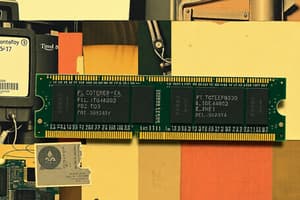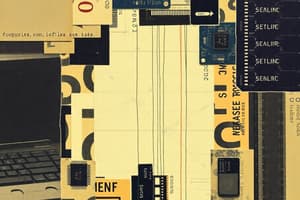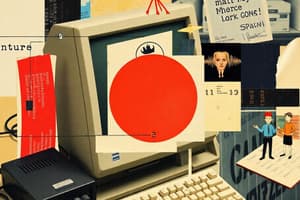Podcast
Questions and Answers
What is the primary function of CamScanner?
What is the primary function of CamScanner?
- Editing photos
- Scanning documents (correct)
- Playing music
- Creating spreadsheets
Which feature is likely NOT associated with CamScanner?
Which feature is likely NOT associated with CamScanner?
- Photo editing (correct)
- Optical Character Recognition (OCR)
- Cloud storage
- Document sharing
In which scenarios would CamScanner be most useful?
In which scenarios would CamScanner be most useful?
- Digitizing paper documents (correct)
- Listening to podcasts
- Creating multimedia presentations
- Playing video games
Which type of device is CamScanner primarily designed for?
Which type of device is CamScanner primarily designed for?
What is a common benefit of using CamScanner?
What is a common benefit of using CamScanner?
Flashcards
What is CamScanner?
What is CamScanner?
CamScanner is a mobile app that allows users to scan documents, photos, and other materials using their smartphone's camera.
What file formats can CamScanner save scans in?
What file formats can CamScanner save scans in?
CamScanner converts scans into digital formats like PDF, JPG, and other file types.
Can you edit scanned documents in CamScanner?
Can you edit scanned documents in CamScanner?
CamScanner allows users to edit scanned documents, including cropping, rotating, and enhancing their quality.
How does CamScanner help organize and manage scans?
How does CamScanner help organize and manage scans?
Signup and view all the flashcards
Who uses CamScanner?
Who uses CamScanner?
Signup and view all the flashcards
Study Notes
Computer Peripheral Devices
- Not a peripheral device: CPU
- Peripheral devices include input and output devices, such as keyboard, monitor, and mouse.
System Unit Ports
- A port is a connection point in the system unit for transferring data between various devices and the computer.
Read-Only Memory (ROM)
- ROM is computer memory that cannot be altered by the user. New data cannot be written to it.
Data Measurement Units
- 8 bits equal a byte.
Megabyte Calculation
- A megabyte (MB) equals 1024 x 1024 bytes.
Device Drivers
- They enable input or output devices to communicate with the computer system.
Computer Memory Types
- The two fundamental types of computer memory are primary and secondary.
Optical Disks
- A CD is a non-erasable disk used to store digitized audio.
Computer Processing
- Outputting is the process of producing information for the user.
Output Unit Function
- The output unit transforms data entered by a user into a computer-understandable format. false
Data Input and Output
- The raw material that is processed is Data, information
Computer Characteristics
- The characteristic that is not a characteristic of a computer is I.Q.
Computer Memory and Storage
- Memory is an electronic storage place for data that can be accessed.
Memory Size
- The size of main memory depends on the address bus's size.
Independent Function
- Secondary memory is independent of address bus.
MAR Abbreviation
- MAR stands for Memory address register.
Optical Disks and Storage
- Optical disks are a good option for high-capacity secondary storage.
Optical Disk Technology
- The technology used in optical disks is laser beam.
Storage Capacity
- The storage capacity of optical disks is calculated by multiplying the number of sectors by the number of bytes per sector.
Disk Rotation
- The rotational speed of a disk is inversely related to its radius.
Sector Size
- Sectors on a disk have a constant size.
Access Time
- The range of access times for optical disks is generally between 100 and 300 milliseconds.
Laser Technology Use
- DVDs use laser beam technology.
Input Devices
- A bar code reader is an input device.
Computer Types
- A supercomputer interacts with a television set.
Computer Classifications
- Maxicomputer is not one of the computer classifications.
Computer Users
- End-users are computer users that aren't professionals.
Powerful Computer Types
- Supercomputers are the most powerful types of computers.
Kilobytes
- A kilobyte (KB) is equal to 1024 bytes.
Memory Allocation
- Memory management is the process of allocating main memory.
Primary Storage
- The primary storage unit is also called memory.
Memory Types
- QRAM is not a standard memory type.
Logic Chip Name
- A microprocessor is another name for a logic chip.
Data Representation
- Data on a computer is represented by the binary system.
Data Characters
- A single letter, digit, or special character on a computer is represented by a bit.
Memory Capacity Measurement
- Memory capacity is measured in Megabytes.
Cache Location
- The L1 cache is built into the CPU chip.
Processor Speed Measurement
- Processor speed is measured in megahertz.
Screen Pixel Measurement
- The gap between pixels is called dot pitch.
Screen Symbol
- A icon is a pictorial screen symbol representing computer activities.
Image Display
- Viewing an image on a computer screen is called screen output.
Optical Character Recognition
- A wand reader is a device for optical character recognition.
Mark Sensing
- OMR (Optical Mark Recognition) is also referred to as "mark sensing."
Screen Refresh Rate
- The rate in which a screen refreshes is called raster rate.
Studying That Suits You
Use AI to generate personalized quizzes and flashcards to suit your learning preferences.




